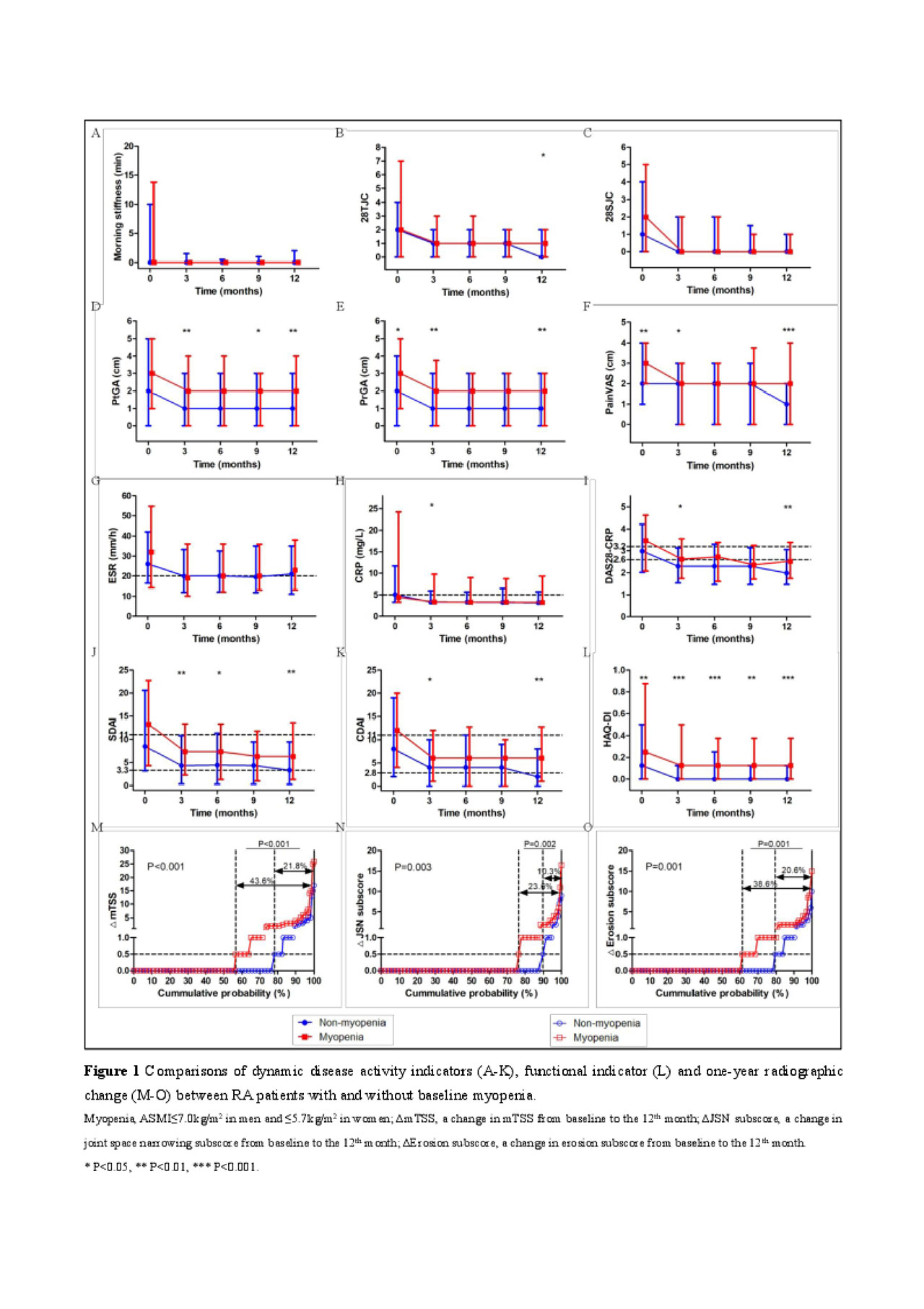Session Information
Date: Sunday, November 10, 2019
Title: RA – Diagnosis, Manifestations, & Outcomes Poster I: Risk Factors, Predictors, & Prognosis
Session Type: Poster Session (Sunday)
Session Time: 9:00AM-11:00AM
Background/Purpose: Obesity paradox based on body mass index (BMI) in rheumatoid arthritis (RA) remain elusive. Our previous cross-sectional study has reported myopenia is associated with joint damage in RA. Here we aimed to explore the association of body composition (BC) with RA clinical outcomes in a real-world cohort.
Methods: Consecutive Chinese patients with RA who fulfilled the 1987 revised criteria of ACR or 2010 ACR/EULAR classification criteria for RA were recruited from August 2015 to January 2018. RA patients were treated according to the T2T strategy and completed at least one-year follow-up. BC was assessed by bioelectric impedance analysis and clinical data were collected at baseline, 3rd, 6th, 9th and 12th months. Myopenia was defined by appendicular skeletal muscle mass index (ASMI) ≤7.0kg/m2 in men and ≤5.7kg/m2 in women. One-year radiographic progression was defined as a change of Sharp/van der Heijde modified total sharp score (mTSS) ≥0.5 units.
Results: There were 305 RA patients [median age 49 (IQR 39-58) years old with 84.6% women] completed one year follow-up and 31.8% showed radiographic progression. RA patients with radiographic progression showed worse disease characteristics, lower BMI and lower muscle mass with higher prevalence of myopenia (62.9%-67.0% vs. 30.8%-38.0%) compared with those without radiographic progression during one-year follow-up. After treatment, all muscle indicators increased at almost all visits in all RA patients group especially in those without radiographic progression. Compared with those without baseline myopenia, RA patients with baseline myopenia (45.9%) had worse disease activity indicators at the 12th month, worse functional indicators at each visit, and higher percentage of radiographic progression (43.6% vs.21.8%, all P< 0.05, Figure 1). Multivariate logistic regression analysis showed baseline myopenia was associated with a significantly higher likelihood of radiographic progression (OR=2.139, 95%CI: 1.221-3.747). ROC curve analysis and multivariate logistic regression analysis showed that in patients without baseline myopenia, decreased ASMI from baseline to the 3rd (OR=2.849, 95%CI: 1.156-7.018), 9th (OR=2.837, 95%CI: 1.116-7.209) and 12th (OR=3.791, 95%CI: 1.467-9.794) months revealed significantly higher likelihoods of radiographic progression, with cutoff values of -0.021, -0.156 and -0.083 kg/m2 respectively.
Conclusion: Our data indicated decreased muscle mass, a novel predictive indicator for one-year radiographic progression in RA which imply the importance of dynamic monitoring of BC especially muscle mass during RA treatment.
To cite this abstract in AMA style:
Lin J, Ma J, Li Q, Mo Y, Yang L, Chen L, Chen C, Wang J, Zheng D, Dai L. Decreased Muscle Mass, a Novel Predicting Indicator for One-year Radiographic Progression in Rheumatoid Arthritis: A Real-world Cohort Study [abstract]. Arthritis Rheumatol. 2019; 71 (suppl 10). https://acrabstracts.org/abstract/decreased-muscle-mass-a-novel-predicting-indicator-for-one-year-radiographic-progression-in-rheumatoid-arthritis-a-real-world-cohort-study/. Accessed .« Back to 2019 ACR/ARP Annual Meeting
ACR Meeting Abstracts - https://acrabstracts.org/abstract/decreased-muscle-mass-a-novel-predicting-indicator-for-one-year-radiographic-progression-in-rheumatoid-arthritis-a-real-world-cohort-study/

